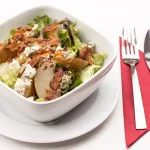The Best Fluffy Pancakes recipe you will fall in love with. Full of tips and tricks to help you make the best pancakes.
There’s something incredibly comforting about biting into a soft, fluffy cake donut — a perfect balance of sweetness, texture, and that nostalgic homemade touch. Unlike traditional yeast donuts, cake donuts have a tender crumb and a rich flavor that’s easy to customize with your favorite spices and toppings. Whether you’re a seasoned baker or just starting out, making cake donuts at home is a rewarding experience that fills your kitchen with irresistible aromas and yields beautiful treats that look as good as they taste.
In this step-by-step recipe, I’ll guide you through everything you need to know to create the most delicious and beautiful cake donuts from scratch. From mixing the perfect batter to frying or baking them to golden perfection, and finally decorating them with classic glazes and fun toppings — you’ll discover how simple it can be to make bakery-quality donuts right in your own home. Ready to impress your family and friends with these delightful sweet treats? Let’s get started!
Ingredients You’ll Need for the Perfect Cake Donuts
Creating delicious and beautiful cake donuts starts with having the right ingredients. Each component plays a crucial role in building the perfect texture, flavor, and appearance of your donuts. Here’s a breakdown of the key ingredients you’ll need, along with some tips on how to choose the best quality for your recipe.

Key Dry Ingredients (All-Purpose Flour, Baking Powder, Cinnamon)
- All-Purpose Flour: This is the foundation of your donut batter. All-purpose flour provides the right balance of protein to create a tender yet sturdy crumb. Make sure to measure your flour correctly—too much can make the donuts dense, while too little can cause them to fall apart.
- Baking Powder: This leavening agent helps your cake donuts rise, giving them a light and fluffy texture. Using fresh baking powder ensures your donuts will puff up nicely during frying or baking.
- Cinnamon (Optional): Adding ground cinnamon to your dry mix infuses a warm, aromatic flavor that pairs beautifully with the sweetness of the donut. You can adjust the amount or substitute it with other spices like nutmeg or allspice for different flavor profiles.
Wet Ingredients (Buttermilk, Eggs, Vanilla Extract)
- Buttermilk: Buttermilk adds moisture and a subtle tanginess to your donuts. Its acidity reacts with the baking powder to create an even lighter texture. If you don’t have buttermilk on hand, you can make a quick substitute by adding a tablespoon of lemon juice or vinegar to a cup of milk and letting it sit for a few minutes.
- Eggs: Eggs bind the ingredients together and contribute to the richness of the batter. They also help in achieving the perfect golden color and tender crumb.
- Vanilla Extract: A splash of vanilla extract adds depth and sweetness to your donut batter, rounding out the flavors for that classic bakery taste.
Optional Flavor Enhancers (Cinnamon, Nutmeg)
- Spices like cinnamon and nutmeg are fantastic for adding warmth and complexity to your donuts. Feel free to experiment with small amounts to find your favorite combination. Some recipes even include a hint of ground ginger or cardamom for a unique twist.
Tools and Equipment (Donut Cutter, Deep Fryer or Heavy Pan, Cooling Rack)
- Donut Cutter: To achieve the perfect donut shape, a donut cutter is essential. If you don’t have one, you can use two round cookie cutters of different sizes or even a glass and a bottle cap.
- Deep Fryer or Heavy Pan: Frying your cake donuts requires consistent oil temperature, so using a deep fryer or a heavy-bottomed pan helps maintain even heat. A thermometer is highly recommended to monitor the oil temperature and prevent greasy or undercooked donuts.
- Cooling Rack: After frying, place your donuts on a cooling rack to drain excess oil and cool evenly. This prevents sogginess and helps the glaze or toppings adhere better.
Step-by-Step Cake Donut Recipe
Making cake donuts from scratch is easier than you might think, especially when you follow a clear, step-by-step process. Below, I’ll walk you through each stage — from preparing the batter to frying or baking your donuts perfectly — so you can enjoy delicious, bakery-style treats right at home.
Preparing the Donut Batter (Mixing Tips and Tricks)
Start by gathering all your ingredients and measuring them precisely. In a large mixing bowl, whisk together your dry ingredients — all-purpose flour, baking powder, sugar, and any spices like cinnamon or nutmeg. In a separate bowl, beat the wet ingredients — buttermilk, eggs, vanilla extract, and melted butter or oil — until well combined.
Gradually add the wet ingredients to the dry mix, stirring gently until just combined. Avoid overmixing; a few lumps are okay. Overmixing can develop gluten in the flour, leading to tough donuts instead of soft, tender ones.
Shaping the Donuts with a Donut Cutter
Lightly flour your work surface to prevent sticking. Roll the donut dough to about ½ inch thickness. Using a donut cutter, press down firmly to cut out donut shapes. Don’t worry if your edges aren’t perfectly smooth — they’ll round out slightly during frying or baking.
If you don’t have a donut cutter, you can use two round cutters or glasses — a larger one for the outer edge and a smaller one for the donut hole.
Frying vs Baking Cake Donuts (Which Method to Choose)
Frying: Traditional cake donuts are fried to achieve that golden, slightly crispy exterior with a soft, moist inside. Heat your oil in a deep fryer or heavy pan to about 350°F (175°C). Carefully place a few donuts in the hot oil, being careful not to overcrowd the pan. Fry for about 1-2 minutes on each side or until golden brown. Remove with a slotted spoon and place on a cooling rack lined with paper towels to drain excess oil.
Baking: For a lighter and less oily option, bake your donuts. Preheat your oven to 375°F (190°C). Place the donuts on a parchment-lined baking sheet and bake for about 12-15 minutes or until they’re lightly golden and spring back when pressed.
Tips for Frying Donuts Perfectly (Oil Temperature, Timing)
Maintaining the right oil temperature is crucial. Too hot, and your donuts will brown too quickly on the outside while remaining raw inside. Too cool, and they’ll absorb too much oil and become greasy.
Use a kitchen thermometer to monitor the oil temperature, keeping it steady around 350°F (175°C). Fry in small batches to avoid temperature drops. Flip donuts gently with tongs or a slotted spoon halfway through cooking for even color and texture.
Once fried, place the donuts on a cooling rack to drain and cool slightly before glazing or decorating. This helps keep them crisp on the outside and soft inside.
Decorating and Finishing Your Cake Donuts
The fun part of making cake donuts is adding those final touches that make them look irresistible and taste even better. From classic glazes to creative toppings, decorating your donuts is where you can get creative and customize your treats to match any occasion or mood. Here’s how to glaze, decorate, and store your cake donuts perfectly.
Classic Powdered Sugar Glaze Recipe
One of the simplest and most popular finishes for cake donuts is a classic powdered sugar glaze. To make it, whisk together powdered sugar, a splash of milk (or buttermilk for extra tang), and a little vanilla extract until smooth and pourable. Adjust the milk quantity to get your desired glaze thickness — thin enough to drip smoothly but thick enough to coat.
Dip the tops of your cooled donuts into the glaze, allowing the excess to drip off. Place the donuts on a wire rack so the glaze can set without pooling. This shiny, sweet coating adds a delightful sweetness and a beautiful sheen to your donuts.
Fun Icing and Topping Ideas (Sprinkles, Cinnamon Sugar)
For more colorful and flavorful options, try these popular toppings:
- Sprinkles: While the glaze is still wet, generously sprinkle your favorite colorful or themed sprinkles for a festive look.
- Cinnamon Sugar: Toss warm donuts in a mixture of cinnamon and granulated sugar for a simple but delicious coating that adds a crunchy texture and warm flavor.
- Chocolate Drizzle: Melt some chocolate chips or candy melts and drizzle over glazed or plain donuts for a rich finish.
- Nuts and Coconut: Chopped nuts, shredded coconut, or even crushed cookies can add texture and flavor when sprinkled on top of wet glaze or icing.
Feel free to mix and match these toppings to create your own signature donut style!
How to Make Your Donuts Look Beautiful
Presentation matters, especially when you want to impress friends or family. Here are some tips to make your donuts look stunning:
- Use a clean cooling rack to let excess glaze drip off neatly.
- Arrange donuts on pretty plates or cake stands for serving.
- Add edible decorations like edible glitter or gold dust for a touch of elegance.
- Pipe small designs or messages using colored icing or melted chocolate.
- Use contrasting toppings for eye-catching effects — like bright sprinkles over white glaze or dark chocolate drizzle over cinnamon sugar coating.
Storing Your Donuts to Keep Them Fresh
Cake donuts are best enjoyed fresh, ideally within a day or two. However, if you need to store them:
- Keep donuts in an airtight container at room temperature. Avoid refrigeration as it can dry them out.
- Place a sheet of parchment paper between layers to prevent sticking.
- For longer storage, freeze donuts in a sealed container. To enjoy later, thaw at room temperature and warm slightly in the oven or microwave before serving.
Proper storage ensures your donuts remain soft, moist, and delicious for as long as possible.
Frequently Asked Questions and Tips
Making cake donuts can raise some common questions, especially if you’re new to baking or frying donuts at home. Below, I’ve compiled answers to the most frequently asked questions along with helpful tips to ensure your donuts turn out perfectly every time.
Can I Bake Cake Donuts Instead of Frying?
Yes! Baking is a fantastic alternative if you want a lighter, less greasy donut. While frying creates that classic crispy exterior, baked cake donuts are still soft, flavorful, and easier to prepare without needing a lot of oil. Just make sure to grease your donut pans well or use non-stick spray, and bake at 375°F (190°C) for about 12-15 minutes. You can even brush baked donuts lightly with melted butter before glazing to add extra richness.
How to Fix Donut Batter That’s Too Thick or Thin?
If your batter feels too thick, it can be difficult to shape and might produce dense donuts. To thin it out, add a tablespoon of buttermilk or milk at a time until you reach a smooth, spoonable consistency.
On the other hand, if the batter is too thin and runny, your donuts might spread too much or become flat. To thicken it, sift in a little extra flour (start with one tablespoon), then gently fold it in. Remember, it’s important not to overmix when adjusting to keep your donuts tender.
Best Donut Variations to Try Next
Once you master the classic cake donut, the possibilities are endless! Here are some delicious variations to explore:
- Chocolate Cake Donuts: Add cocoa powder to the batter for a rich chocolatey treat.
- Pumpkin Spice Donuts: Incorporate pumpkin puree and warm spices like cinnamon, nutmeg, and cloves.
- Glazed Lemon Donuts: Add lemon zest to your batter and finish with a tangy lemon glaze.
- Filled Donuts: After frying or baking, inject your donuts with jams, custards, or chocolate ganache for an indulgent surprise.
Feel free to experiment with different flavors and toppings to make each batch uniquely yours!
Troubleshooting Common Donut Problems
- Donuts Are Greasy: This usually means the oil temperature was too low. Always use a thermometer and maintain around 350°F (175°C). Fry donuts in small batches to avoid cooling the oil.
- Donuts Are Dense or Heavy: Overmixing the batter or using too much flour can cause this. Mix just until combined, and measure flour carefully.
- Donuts Fall Apart When Fried: The batter may be too wet or not thick enough. Adjust with a bit more flour and ensure your batter holds together before shaping.
- Uneven Coloring: Make sure your oil temperature is steady and flip donuts halfway through frying for an even golden color on both sides.






[…] you’re a fan of classic cake donuts, you might enjoy this step-by-step Cake Donut Recipe for a more traditional […]